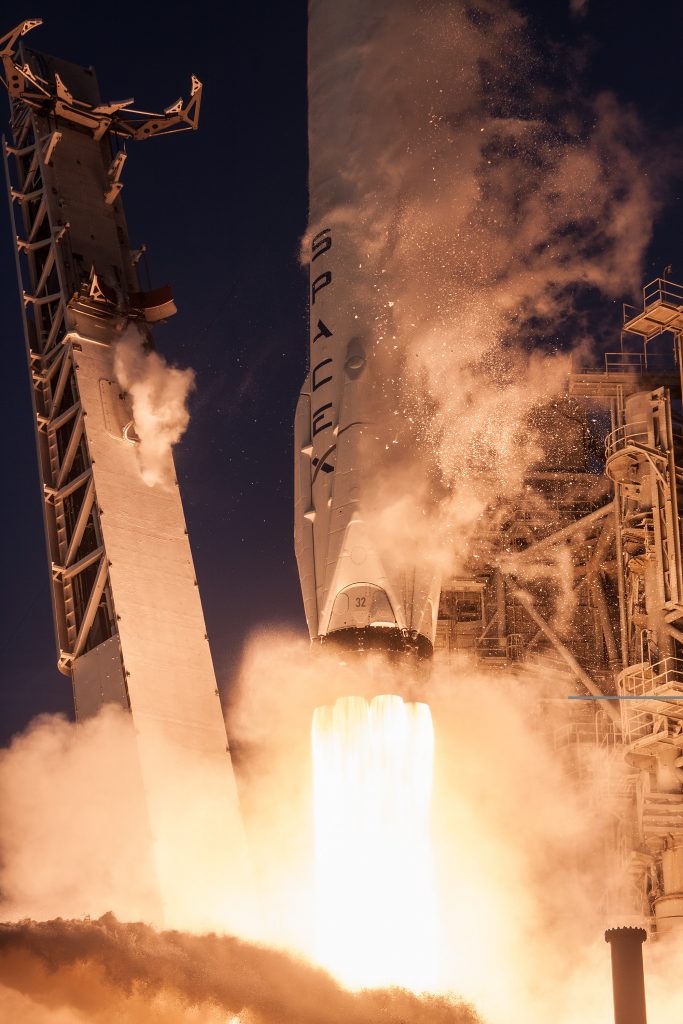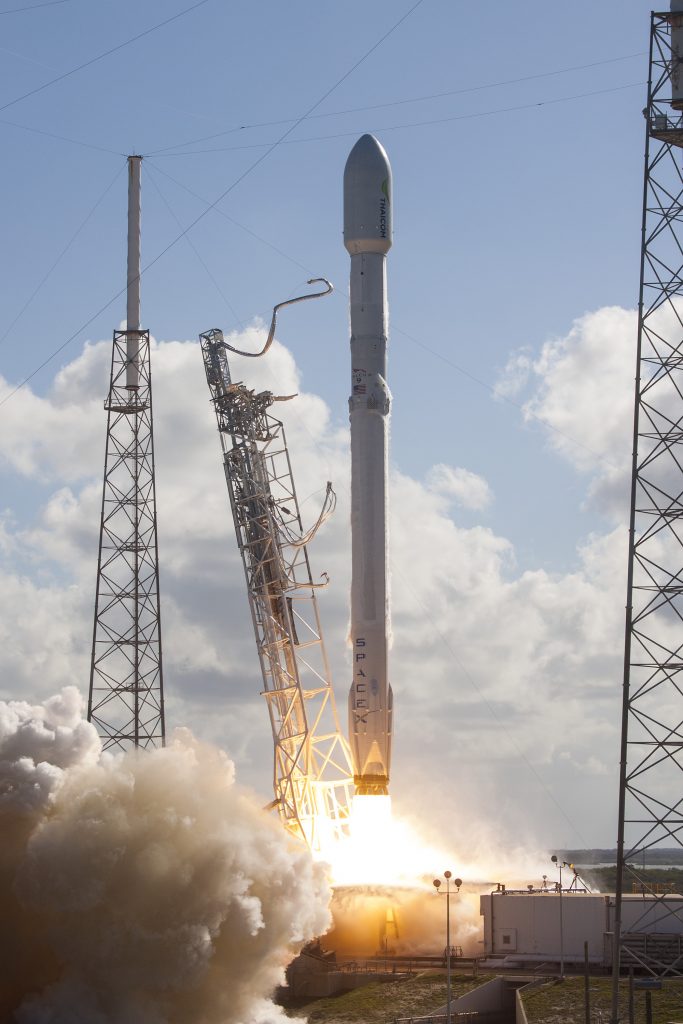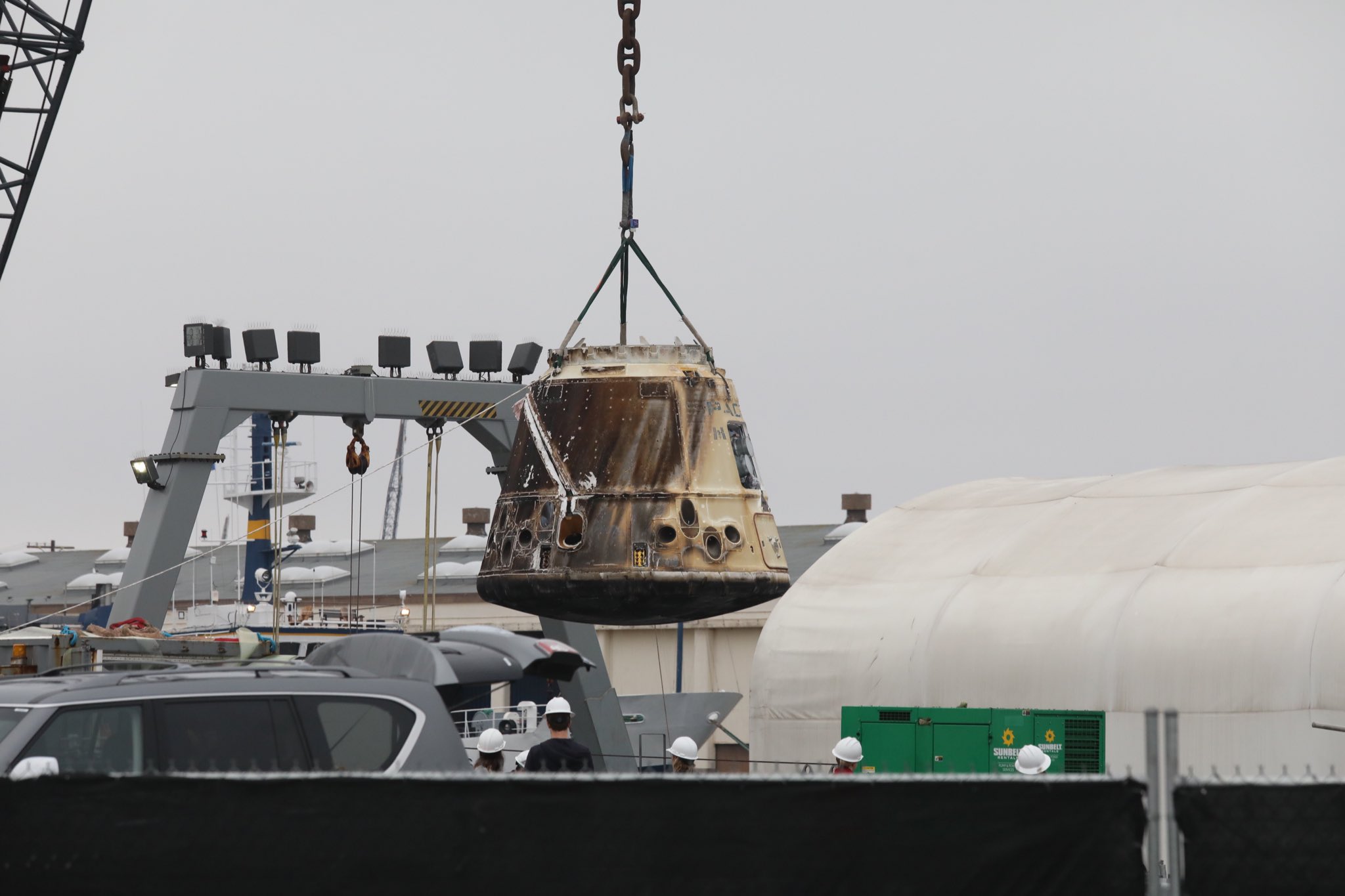
SpaceX is targeting Monday, April 2 for its fourteenth Commercial Resupply Services mission (CRS-14) to the International Space Station. The instantaneous launch is targeted for 4:30 p.m. EDT, or 20:30 UTC, from Space Launch Complex 40 (SLC-40) at Cape Canaveral Air Force Station, Florida. A backup launch opportunity is available on Tuesday, April 3 at 4:08 p.m. EDT, or 20:08 UTC.
Dragon will separate from Falcon 9’s second stage about 10 minutes after liftoff and attach to the space station on Wednesday, April 4. Both Falcon 9 and the Dragon spacecraft for the CRS-14 mission are flight-proven. Falcon 9’s first stage previously supported the CRS-12 mission in August 2017 and Dragon previously supported the CRS-8 mission in April 2016. SpaceX will not attempt to recover Falcon 9’s first stage after launch.
 |
|
Launch date:
|
April 2, 2018
Instantaneous Launch Window:
|
4:30 p.m. EDT/20:30 UTC
Backup Launch Window:
|
Tuesday, April 3 (4:08 p.m. EDT/20:08 UTC)
Launch site:
|
Space Launch Complex 40 (SLC-40) at Cape Canaveral Air Force Station, Florida
{colsp=2}
[highlight]L[eventtimer]2018-04-02 20:30:00;%c%%ddd%/%hh%:%mm%:%ss%[/eventtimer][/highlight]

Mission Patch
Launch coverage: (Begin about 20 minutes before liftoff.)
[ame="https://www.youtube.com/watch?v=BPQHG-LevZM"]CRS-14 Mission - YouTube[/ame]
Payload:
This flight delivers scientific investigations looking at severe thunderstorms on Earth, the effects of microgravity on production of high-performance products from metal powders, and growing food in space. Dragon also carries cargo for research in the National Laboratory, operated by the Center for the Advancement of Science in Space (CASIS), including testing the effects of the harsh space environment on materials, coatings and components; identifying potential pathogens aboard the station; and investigating an antibiotic-releasing wound patch.
Highlights of research to be delivered to the station include:
Capturing Sprites and Elves

The Atmosphere-Space Interactions Monitor (ASIM) surveys severe thunderstorms in Earth’s atmosphere and upper-atmospheric lightning, or transient luminous events, from its perch on the exterior of the European Space Agency (ESA) Columbus module. These include sprites, flashes caused by electrical break-down in the mesosphere; the blue jet, a discharge from cloud tops upward into the stratosphere; and ELVES, concentric rings of emissions caused by an electromagnetic pulse in the ionosphere.

This illustration shows the variety of upper atmospheric phenomena powered by thunderstorms. Terrestrial Gamma Ray Flashes (TGFs) are burst of gamma-rays from thunderstorms accompanied by energetic electrons and positrons. Transient Luminous Emissions (TLEs) are electrical discharges that include the blue glimpses at the top of thunderstorms, the blue jet, gigantic jet and the red sprite. TLEs also include elves, the rapidly expanding rings of emissions at the bottom ionosphere, and the haloes.
Credits: DTU Space; TGF: NASA
ASIM advances understanding of the effect of thunderstorms on Earth’s atmosphere, helping to improve atmospheric models and meteorological and climatological predictions. It also contributes to understanding the effect of dust storms, urban pollutants, forest fires, and volcanoes on cloud formation, as well as electrification and intensification of hurricanes and their relation to eye-wall lightning activity.
Metal Powder Fabrication
The NASA Sample Cartridge Assembly (MSL SCA-GEDS-German) experiment determines underlying scientific principles for a fabrication process known as liquid phase sintering, in microgravity and Earth-gravity conditions.
On earth, liquid phase sintering works like building a sandcastle with just-wet-enough sand; heating a powder forms interparticle bonds and formation of a liquid phase accelerates this solidification, creating a rigid structure. But in microgravity, settling of powder grains does not occur and larger pores form, creating more porous and distorted samples than Earth-based sintering. Sintering has diverse applications on Earth, including in metal cutting tools, automotive engine connecting rods, and self-lubricating bearings. It has potential as a way to perform in-space fabrication and repair, such as building structures on the moon or creating replacement parts during extraterrestrial exploration.
Testing Materials in Space

The Materials ISS Experiment Flight Facility (MISSE-FF) with MISSE Sample Carriers (MSCs) in the fully open position exposing samples/experiments to the harsh environment of space in low-Earth Orbit (LEO). Image courtesy of Alpha Space.
Credits: Alpha Space
The Materials ISS Experiment Flight Facility (MISSE-FF) provides a unique platform for testing how materials, coatings, and components react in the harsh environment of space, which includes exposure to ultraviolet and ionizing radiation, atomic oxygen, charged particles, thermal cycles, electromagnetic radiation, and micro-meteoroids.
A continuation of previous MISSE payloads, MISSE-FF’s new design eliminates the need for Extravehicular Activities (EVA) for these investigations. The platform will be extracted from Dragon’s trunk and installed on the EXPRESS Logistics Carrier ELC2 by the Canadarm2 robotic arm. MISSE-FF’s new technology includes power and data collection options and the ability to take pictures of each sample on a monthly basis, or more often if required, allowing scientists to monitor sample status throughout flight. The testing benefits a variety of industries, including automotive, aeronautics, energy, space, and transportation.
Drug Development in Space

From left, Matthew Romeyn and Dr. Ye Zhang, project scientists, place Arabidopsis seeds in Veggie Passive Orbital Nutrient Delivery System (PONDS) units inside a laboratory at the Space Station Processing Facility at NASA’s Kennedy Space Center in Florida.
Credits: NASA/Daniel Casper
Comparative Real-time Metabolic Activity Tracking for Improved Therapeutic Assessment Screening Panels (Metabolic Tracking) examines effects of microgravity on the metabolic impact of five different therapeutic compounds, evaluating the use of autobioluminescent human tissue culture for continuous tracking of metabolic activity without destroying the sample. This investigation determines the feasibility of developing improved pharmaceuticals in microgravity using a new method to test the metabolic impacts of drug compounds. This could lead to more effective, less expensive drugs.
These investigations are just a sample of the new science to be conducted aboard the orbiting microgravity laboratory.
Launch Vehicle:
Falcon 9 FT represents an evolved version of SpaceX’s Falcon 9 v1.1 rocket incorporating a number of performance enhancements to enable the launch vehicle to lift heavy satellites to Geostationary Transfer Orbit while preserving the option of re-using the first stage. Operated by Space Exploration Technologies, the rocket represents the third evolutionary stage of the Falcon 9. The Falcon 9 Full Thrust (FT) vehicle is also known as ‘Falcon 9 Upgrade,’ ‘Enhanced Falcon 9,’ ‘Full Performance Falcon 9’ and ‘Falcon v1.2.’
The Falcon 9 FT launch vehicle is based on the Falcon 9 v1.1 (F9R) which in turn built on the original Falcon 9, retrospectively known as the v1.0 version of the rocket. Falcon 9 v1.0 was inaugurated in 2010 and flew successfully five times until 2013 when it was succeeded by the v1.1 version of the launcher. Falcon 9 v1.1 is retired after 15 missions, one of which was a failure. The v1.1 version itself was subject to a stepwise evolution, notably the implementation of reusability technologies on its first stage. These systems, among other changes, are standard on the Falcon 9 FT that premieres in late 2015 and is likely the final version of Falcon 9 with the maximum possible performance.

The Falcon 9 Full Thrust launch vehicle retains the overall design of the previous Falcon 9 rockets as a two-stage-to-orbit launch vehicle. Its first stage includes all systems necessary for an operational re-use of stages while the second stage is operated as an expendable rocket stage.
Falcon 9 FT stands 70 meters tall, is 3.66 meters in diameter and has a launch mass of 549,054 Kilograms. Both stages use sub-cooled Liquid Oxygen and chilled Rocket Propellant 1 as propellants consumed by Merlin 1D engines, nine of which are installed on the first stage while the second stage hosts a single Merlin 1D engine optimized for operation in vacuum.
SpaceX lists the payload capability of the Falcon 9 FT as 22,800 Kilograms to Low Earth Orbit and 8,300kg to Geostationary Transfer Orbit – these figures are for the fully expendable configuration of the vehicle. Leaving sufficient propellant margin for the return of the first stage to the Autonomous Spaceport Drone Ship for later re-use cuts the payload mass to GTO to around 5,500 Kilograms.
To achieve an operational re-usability of Falcon 9 first stages, all Falcon 9 FT rockets are outfitted with a reaction control system, four grid fins for steering and four deployable landing legs. Dropping the second stage off on its way to orbit, the first stage goes through a series of complex propulsive maneuvers before guiding itself through the atmosphere towards a target landing site for a soft touchdown under the power of one of its Merlin engines to be re-used on a future flight.
Specifications
Height:|
- 70m
Diameter:|
- 3.66m
Launch Mass:|
- 549,054kg
Stages:|
- 2
Boosters:|
- None
Mass to LEO:|
- 22,800 kg
Mass to GTO:|
- 8,300 kg
Mass to Mars:|
- 4,020 kg
Launch Cost:|
- $62M
Bonus for Orbinauts!
CRS-14 Launch Scenario
L-2 Weather forecast by Patrick AFB Weather Squadron: 80% GO!
Time
|
Temps
|
Humidity
|
Pressure
|
Solar Activity
|
Surface Visibility
|
Wind
|
Weather
2 Apr 2018 1627-1632 EDT (2027-2032 UTC)
|
2 Apr 2018 1627-1632 EDT (2027-2032 UTC)
77 °F
|
60%
|
30.03 inHg
|
Low
|
7 miles
|
120° @ 10-15 (200’)
|
Isolated rain showers
Launch day probability of violating launch weather constraints: 20%
Primary concern(s): Flight Through Precipitation, Cumulus Cloud Rule
Delay day probability of violating launch weather constraints: 20%
Primary concern(s): Cumulus Cloud Rule, Thick Cloud Layer Rule
(Latest weather forecast is available here.)
Links:
Last edited:

